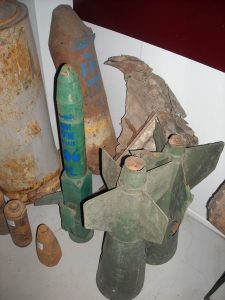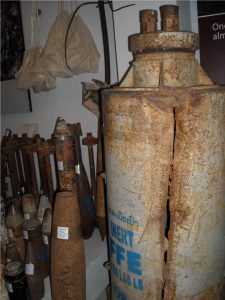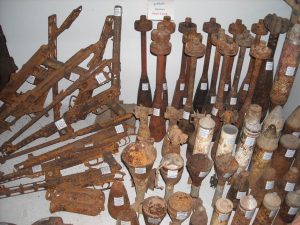HISTORICAL JOURNEYS: Laos and the UXO Museum

Meg Drown explores the continued significance of the Vietnam War in the form of the UXO Museum in Laos, a site she visited on July 4, 2016.
By Meg Drown
About five months ago, I visited the People’s Democratic Republic of Laos, a beautiful, little-understood country in Southeast Asia that shares a border with Vietnam, Thailand, Cambodia, and Myanmar. When I talked to family and friends before I embarked on my trip to Laos, I would consistently receive the response “Where is that?” Ironically, our country is responsible for the tragedy this country experiences everyday, yet many–if not most–Americans ever think of Laos. This tragedy manifests itself in the form of Unexploded Ordnance – or UXO for short – which are remnants of the “Secret War” in Laos during the Vietnam War. Although the United States did not recognize our involvement in this “Secret War” until recently, we were responsible for making Laos – not Vietnam, Cambodia, Iraq, or Afghanistan – the most bombed country per capita in the history of the world.
As tragic as the war was – killing more than 50,000 Lao civilians – the unexploded remnants of the war prove to be just as tragic, killing more than 20,000 civilians since the end of the war in 1975. Among those who have died because of UXO, 40% have been children, and these are fatalities alone. Many more Lao civilians do not die on impact of the explosion, but rather receive life-long injuries that hinder their ability to farm and provide for their families. This continued cost of the war is devastating for families in Laos, who subsist off the yield of their rice paddies and depend on the health of their family members to be able to work for their food.
This harrowing reality was revealed to me on July 4th of this year – the 240th anniversary of our country’s independence and the day we are supposed to be celebrating our country’s democracy and freedom. The experience of having visited this museum on our country’s Independence Day proved to be one of the most poignant experiences of my lifetime. It seemed such a paradox that our country should be celebrating in the midst of all of the death and destruction caused during the Vietnam War. As an American tourist in Laos, you don’t know how to begin to apologize for the transgressions of your own country; however, I found that the Lao people did not want my apologies. They have accepted history and understand that we, as volunteers and tourists, are not responsible for the devastation ourselves. In the wake of all of the destruction we have caused there, they have created something positive and beautiful in the form of the attitudes they adopt towards Americans in accepting and welcoming us just as they would do for all of humanity.

Outside the Museum.

Shell casings of rockets, decorated with cleanly trimmed bushes and flowers, lead up to the entrance of the museum.


Just one tiny red dot represents one bombing mission performed by the US Air Force during the Second Indochina War, or the Vietnam War as more commonly known by Americans.

98% of known cluster bomb victims are civilians, and roughly 40% are children.

Jewelry and silverware a local created from UXO. The economy created from the UXO market creates a huge problem in the country of Laos. The demand for UXO by merchants puts the civilians’ lives at risk whose job it is to find and extract this UXO.


Large aircraft bombs such as these are very common around Laos. Civilians will use these shell casings for tasks they may lack basic materials for.









Megan Drown is a sophomore majoring in International Studies and Economics. She studied the global Cold War in HST 296, World History since 1945, in the Spring 2016 semester.